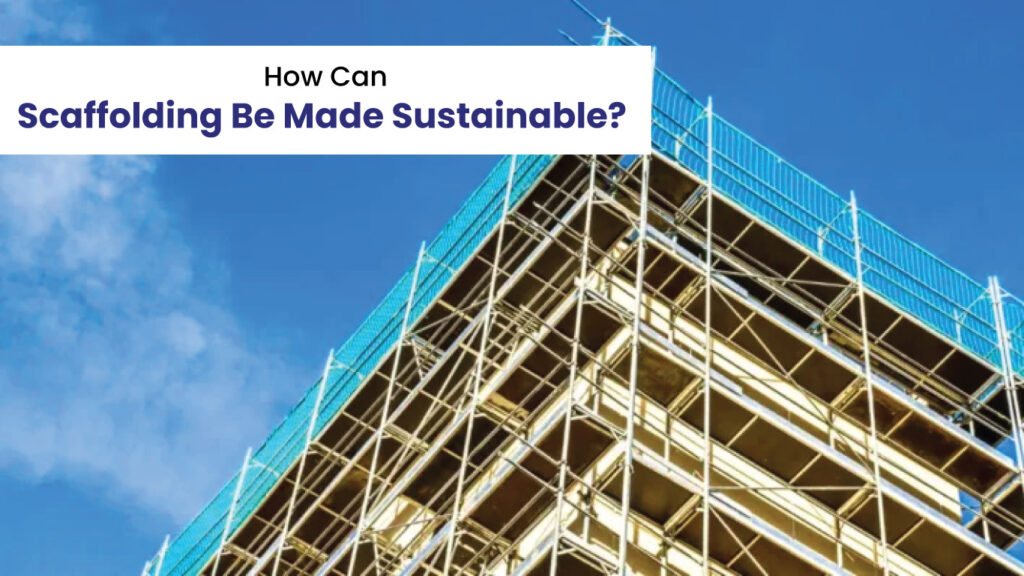
When you’re managing a construction project, scaffolding at the site can ensure safety for workers. With essential support, workers can carry out various construction tasks efficiently. Apart from safety, scaffolding structures can help optimize workflow and allow workers to manage tasks at multiple levels. Once the scaffolding components are designed carefully, they can also ensure structural integrity, minimizing the risks of sudden accidents.In this article, we shall cover how scaffolding can affect the environment and can be made sustainable.
How Does Scaffolding Affect the Environment?
Scaffolding has both a positive and a negative impact on the environment. But the overall impact of the scaffolding structure depends on its material, disposal methods, and construction practices. Here are some ways in which such structures can affect the environment.
Resource Consumption
When materials for scaffolding components are produced, they require a lot of energy and a lot of natural resources. As soon as workers commence with the mining and drilling process, it can lead to air pollution due to gas emissions. Habitat destruction and deforestation can also be the consequences.
Waste Generation
As construction projects are executed, they can generate a lot of waste. Workers also have to think about disposing of scaffolding components if they are damaged or can’t be used ahead. But if workers dispose of components in the way it has to be done, then it causes landfill pollution and degrades the environment.
Disturbance in Habitats
Construction activities related to erecting and disassembling scaffolding structures can disturb local habitats. The disturbance can also have a negative impact on vegetation, ecosystems, and wildlife.
Risks related to Safety
If the scaffolding is not maintained or constructed properly, then it can lead to safety risks to the workers and surrounding environment. Sudden and unexpected accidents or the fall of debris can not only lead to injuries but also environmental damage.
So, with the environmental impact taken into consideration, manufacturers should think about making the scaffolding structures sustainable. On the contrary, workers should prefer erecting crank up scaffolding in addition to greens scaffolding. These have less environmental impact as the components are lightweight and reusable. However, if you manage many construction projects, then consider making scaffolding sustainable.
How Scaffolding Can be Considered Sustainable?
Scaffolding can be made sustainable when manufacturing companies design the components with the aim of reducing environmental impact. But when the team designs various components, it should consider the needs of the project. When designers keep sustainability in mind and design the components, the entire structure is known as greens scaffolding. Let’s check out how companies can make scaffolding sustainable.
Selecting suitable material
Selecting sustainable materials for greens scaffolding can help reduce the impact on the environment. Manufacturers can either use aluminum, recycled steel, or bamboo. Apart from being renewable, such materials are recyclable and have a low carbon footprint. They don’t affect the environment when compared to usual materials.
Modular Design
A modular design can enable workers to disassemble and assemble structures efficiently and in less time. In addition, the modular systems can be reused for numerous projects. Workers will no longer have to bother about using new scaffolding materials for greens scaffolding.
Research and Innovation
When sustainability is a concern, manufacturing companies should invest in the development of scaffolding technologies. The team should also use different design tools and move ahead with advanced manufacturing processes. This can help to drive innovation and promote sustainability in the construction sector.
Energy Efficiency
Through the implementation of energy-efficient practices, companies can reduce energy consumption and emissions of gasses. While the components of greens scaffolding are being manufactured, the team can use renewable energy or optimize equipment and machinery.
Waste Reduction
Reducing waste generation through efficient design and proper planning can also minimize environmental impact. While manufacturers can reuse recycled materials, they can also follow certain strategies while designing greens scaffolding.
Now, when you’re selecting sustainable materials, you first have to evaluate their environmental impact. You should only select materials that cause less pollution. Choosing materials obtained from renewable resources can also be considered. These promote sustainability in the long run because the materials can be replenished quickly.
Finally, every construction company has to follow certain practices to promote sustainability for the environment. While the project is progressing at the site, contractors should set up sustainable scaffolding structures. These will not impact the environment negatively and will also not disrupt the surrounding region. Choosing modular designs for greens scaffolding can also reduce resource consumption and the generation of waste. The structures should also be robust and strong so that there isn’t any need for replacements in the future.
About AAIT Scaffolds
By understanding the need for scaffolding, AAIT Scaffolds is always known to be the leading scaffold distributor in the US. While our team is agile in designing scaffolding parts, we assure reliability and quality for every equipment. A strategic approach also enables our team to deliver the scaffolding components as per their needs and within a certain time span.












 Download
Download
Comments are closed